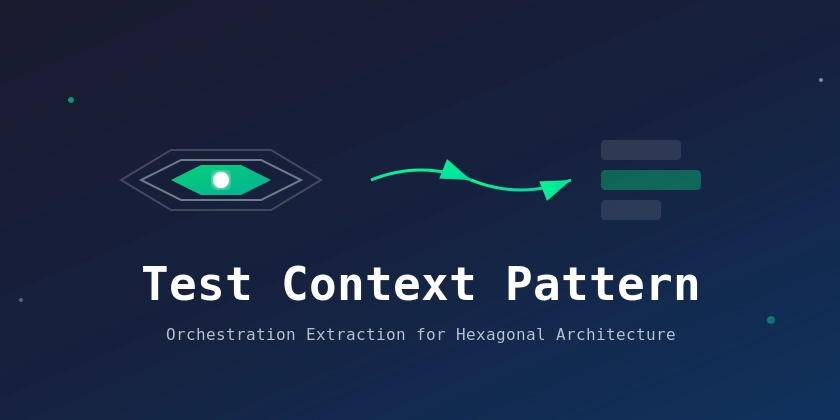Beyond Class-Level Testing – The Orchestration Problem
As experienced developers practicing Test-Driven Development with hexagonal architecture, we’ve evolved beyond testing individual classes. We understand the need to test broader units of business logic – complete flows from drivers through the domain core to adapters.
However, the practice of implementing this understanding still weighs heavily on our test classes:
- Orchestration complexity: Setting up the entire flow requires significant boilerplate
- Mocking ceremony: Each test method needs extensive mock setup and configuration
- Framework coupling: Tests become tied to specific mocking frameworks or paradigms like async programming
- Noise vs. Signal: The actual business scenario gets buried in technical setup code
We know what to test (business flows, not classes), but the how clutters our test methods with orchestration concerns that shouldn’t be there.
A Test Context Pattern: Pure Business Language Testing
A Test Context pattern solves the orchestration problem by extracting all technical concerns from test methods. It leverages JUnit 5 extensions and rich context objects to expose only business-domain language, leaving test methods to express pure business scenarios.
The Core Innovation: Orchestration Extraction
The pattern’s breakthrough is moving all orchestration, mocking, and assertion logic behind the scenes:
- JUnit 5 Extension: Handles context creation and dependency wiring
- Rich Context Object: Provides business-domain vocabulary for test scenarios
- Hidden Complexity: All technical setup, async handling, and mock configuration disappears
- Domain Language: Tests speak only in business terms, not technical implementation
The Pattern in Action
Let’s examine a vulnerability scanning system that demonstrates the Test Context pattern. The (quarkus-mutiny) app gets a request to scan a code library and returns a verdict (Safe or Risky) based on known vulnerabilities. If found risky, it sends a notification.
The Test Class – Pure Business Logic
@ExtendWith(TestContextExtension.class)
@DisplayName("Vulnerabilities scan")
class VulnerabilityTest {
@Test
@DisplayName("When scanning a Java library with a known vulnerability - a 'Risky' verdict should be returned and a notification should be sent")
void javaLibWithVulnerability(TestContext context) {
given(context)
.ofJavaLibrary()
.withKnownVulnerability();
when(context).runScan();
then(context).response()
.verdictShouldBe(Verdict.RISKY)
.reasonShouldContain("Known vulnerability");
then(context).notification()
.shouldBeSent()
.containingText("Known vulnerability");
}
@Test
@DisplayName("When scanning a Java library without any known vulnerability - a 'Safe' verdict should be returned without any notification")
void javaLibWithNoVulnerabilities(TestContext context) {
given(context)
.ofJavaLibrary()
.withoutVulnerabilities();
when(context).runScan();
then(context).response()
.verdictShouldBe(Verdict.SAFE);
then(context).notification()
.shouldNotBeSent();
}
}
Notice how the test method contains zero orchestration code:
- No mock setup or configuration
- No async handling (Mutiny’s
await().indefinitely()is hidden) - No framework-specific APIs
- No technical vocabulary
The test speaks purely in business-domain language: “Java library”, “known vulnerability”, “risky verdict”, “notification sent”. This is the pattern’s key achievement – complete separation of business intent from technical orchestration.
The TestContext – Where Orchestration Lives
All the technical complexity that would normally clutter your test methods gets encapsulated in a single TestContext:
public class TestContext {
private final Request.Builder requestBuilder;
private final VulnerabilitiesApiMock vulnerabilitiesApiMock;
private final NotifierMock notifierMock;
private final Scanner scanner;
private Response response;
// Constructor handles all dependency wiring - hidden from tests
public TestContext(VulnerabilitiesApiMock vulnerabilitiesApiMock, NotifierMock notifierMock) {
this.notifierMock = notifierMock;
this.requestBuilder = Request.builder();
this.vulnerabilitiesApiMock = vulnerabilitiesApiMock;
// Real business logic assembly - no mocking ceremony needed in tests
this.scanner = new Scanner(vulnerabilitiesApiMock, notifierMock, new ResponseBuilder());
}
// Async complexity hidden here
private void run() {
var request = requestBuilder.build();
response = scanner.scan(request).await().indefinitely();
}
// Business-domain vocabulary exposed through fluent API
public static Given given(TestContext context) {
return new Given(context);
}
public static When when(TestContext context) {
return new When(context);
}
public static Then then(TestContext context) {
return new Then(context);
}
}
The TestContext becomes the orchestration layer – it knows about mocks, async handling, object construction, and framework details. Test methods remain blissfully unaware of these concerns.
// Given-When-Then as business language constructs
@RequiredArgsConstructor
public static class Given {
private final TestContext context;
// Business vocabulary - no mention of mocks or technical setup
public Given ofJavaLibrary() {
context.requestBuilder.language(Lang.JAVA);
return this;
}
public Given withKnownVulnerability() {
// Mock orchestration hidden behind business language
context.vulnerabilitiesApiMock.mockVulnerability("CVE-2023-12345");
return this;
}
public Given withoutVulnerabilities() {
context.vulnerabilitiesApiMock.mockNoVulnerabilities();
return this;
}
}
@RequiredArgsConstructor
public static class When {
private final TestContext context;
public void runScan() {
// All async complexity hidden here
context.run();
}
}
@RequiredArgsConstructor
public static class Then {
private final TestContext context;
// Business-focused assertions
public ResponseAsserter response() {
return new ResponseAsserter(context.response);
}
public NotificationAsserter notification() {
return new NotificationAsserter(context.notifierMock);
}
}
And here’s the Extension itself – wiring the test context creation to the tests:
import org.junit.jupiter.api.extension.ExtensionContext;
import org.junit.jupiter.api.extension.ParameterContext;
import org.junit.jupiter.api.extension.ParameterResolutionException;
import org.junit.jupiter.api.extension.ParameterResolver;
public class TestContextExtension implements ParameterResolver {
@Override
public boolean supportsParameter(ParameterContext parameterContext, ExtensionContext extensionContext) throws ParameterResolutionException {
return parameterContext.getParameter().getType() == TestContext.class;
}
@Override
public Object resolveParameter(ParameterContext parameterContext, ExtensionContext extensionContext) throws ParameterResolutionException {
return orchestrateContext();
}
private TestContext orchestrateContext() {
var vulnerabilitiesMock = new VulnerabilitiesApiMock();
var notifierMock = new NotifierMock();
return new TestContext(vulnerabilitiesMock, notifierMock);
}
}
The Pattern’s Brilliance: Business Language DSL
The Given-When-Then classes create a Domain Specific Language for your business context. Test authors think in business terms:
-
ofJavaLibrary()instead ofrequestBuilder.language(Lang.JAVA) -
withKnownVulnerability()instead of mock setup ceremony -
runScan()instead of async orchestration details
The technical how is completely separated from the business what.
Domain-Tailored Mocks and Assertions
Instead of generic mocking frameworks that leak technical details into tests, we create business-focused test doubles:
// Business-focused mock - no Mockito ceremony
public class VulnerabilitiesApiMock implements VulnerabilitiesApi {
private String vulnerability;
@Override
public Uni<List<String>> analyze(Lang language, String lib) {
return Uni.createFrom().item(vulnerability == null ? List.of() : List.of(vulnerability));
}
// Business vocabulary for test setup
public void mockVulnerability(String vulnerability) {
this.vulnerability = vulnerability;
}
public void mockNoVulnerabilities() {
this.vulnerability = null;
}
}
The mock speaks business language – no when().thenReturn() or generic mocking syntax. Test authors configure behavior using domain concepts like “mock vulnerability” and “mock no vulnerabilities”.
Business-Language Assertions
Custom asserters continue the business language theme:
@RequiredArgsConstructor
public class ResponseAsserter {
private final Response response;
// Business assertions - not technical verification
public ResponseAsserter verdictShouldBe(Verdict expectedVerdict) {
var actualVerdict = response.getVerdict();
assertNotNull(actualVerdict);
assertEquals(expectedVerdict, actualVerdict);
return this;
}
public ResponseAsserter reasonShouldContain(String expectedReason) {
var actualReason = response.getReason();
assertNotNull(actualReason);
assertTrue(actualReason.contains(expectedReason));
return this;
}
}
Again, pure business vocabulary: “verdict should be”, “reason should contain”. No technical assertion details leak into the test methods.
The Real Achievement: Orchestration Extraction
What makes this pattern revolutionary for experienced hexagonal architecture practitioners is the complete separation of concerns:
Test Methods: Express only business scenarios in domain language
TestContext: Handles all orchestration, mocking, async complexity
JUnit Extension: Manages context lifecycle and dependency injection
Before: Orchestration Pollution
// What our tests used to look like
@Test
void scanWithVulnerability() {
// Orchestration noise cluttering business intent
var vulnerabilitiesApi = mock(VulnerabilitiesApi.class);
var notifier = mock(Notifier.class);
when(vulnerabilitiesApi.analyze(JAVA, "lib"))
.thenReturn(Uni.createFrom().item(List.of("CVE-123")));
when(notifier.notify(any(), any()))
.thenReturn(Uni.createFrom().voidItem());
var scanner = new Scanner(vulnerabilitiesApi, notifier, new ResponseBuilder());
var request = Request.builder().language(JAVA).name("lib").build();
// Finally - the actual business scenario buried in setup
var response = scanner.scan(request).await().indefinitely();
assertEquals(Verdict.RISKY, response.getVerdict());
verify(notifier).notify(request, List.of("CVE-123"));
}
The business intent is drowning in orchestration details.
After: Pure Business Language
@Test
void javaLibWithVulnerability() {
given(context)
.ofJavaLibrary()
.withKnownVulnerability();
when(context).runScan();
then(context).response()
.verdictShouldBe(Verdict.RISKY);
then(context).notification()
.shouldBeSent();
}
The business scenario is crystal clear – zero orchestration noise.
Key Benefits for Advanced Practitioners
🎯 Pure Business Focus
Test methods become executable business specifications. No technical noise distracts from business intent.
🚀 Dramatic Productivity Gains
Once TestContext infrastructure exists, writing tests becomes incredibly fast – just express business scenarios.
🛡️ True Refactoring Freedom
Internal refactoring never breaks tests. Change implementations, move classes, restructure packages – tests remain green.
🏗️ Architectural Enforcement
The pattern naturally enforces clean architecture – it’s hard to write bad tests when orchestration is extracted.
📚 Living Documentation
Tests become the definitive business specification – readable by domain experts, not just developers.
🔄 Framework Independence
Switch from Mutiny to Reactor, Mockito to custom mocks – test methods remain unchanged.
When to Use This Pattern
The Test Context pattern is ideal when:
- You’re practicing hexagonal architecture
- You have complex business flows spanning multiple classes
- You want test immunity to refactoring
- Your team values readable, maintainable tests
- You’re building domain-rich applications
Conclusion
The Test Context pattern represents a possible evolution in hexagonal architecture testing. By moving all orchestration concerns into a dedicated context and leveraging JUnit 5 extensions, we achieve tests that are:
- Fast like unit tests
- Complete like integration tests
- Maintainable through refactoring immunity
- Readable like business specifications
For developers practicing TDD with hexagonal architecture, this pattern offers a compelling path forward – taking your testing game to the next level while dramatically reducing maintenance overhead.
The pattern transforms testing from a necessary overhead into a powerful design tool that drives better architecture and provides living documentation of your business rules. Testing becomes more fun then ever!
Full implementation is available in the GitHub repository



